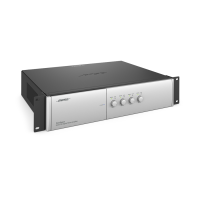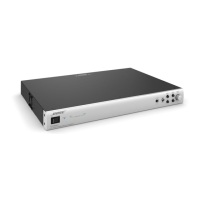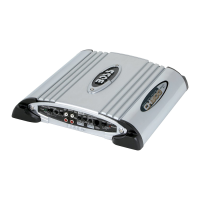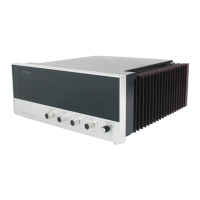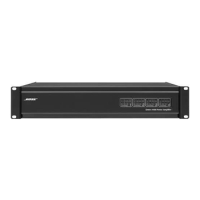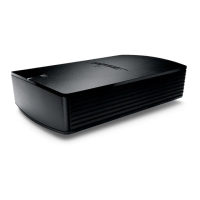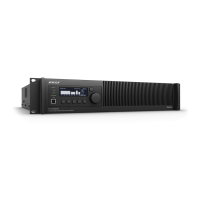53
TEST PROCEDURES
8.3 Apply a 775 mVrms, 1 kHz signal to the
left channel inputs. Reference a dB meter to
the left channel outputs. This is the 0 dB
reference level.
8.4 Connect a 1.00k Ohm resistor between
the REMOTE LEVEL connector +5V and
CH1 (CH2 for right channel) terminals.
8.5 Measure the attenuated output level at
the left channel outputs. It should be -54 dB
+ 5.0 dB.
8.6 Repeat steps 8.3 to 8.5 for the right
channel.
9. Display Test
9.1 On the amplifier front panel, set the left
and right channel gain controls fully CCW.
On the rear panel, set all configuration
switches (7) OFF (down).
9.2 Connect a 4 Ohm load resistor to the left
and right channel 4 Ohm speaker outputs.
9.3 Cycle the amplifier power switch OFF,
then ON. Confirm that both PROTECT
LEDs light, then cycle off with both READY
LEDs lighting after a short delay.
9.4 Apply a 20 mVrms, 1 kHz signal to the left
and right channel amplifier inputs. Set both
level controls fully CW. Verify that both
SIGNAL LEDs light.
9.5 Gradually increase the signal generator
input level while watching the amplifier
display. The SIGNAL LEDs will remain lit as
the -20dB, -12dB and -6dB LEDs light one
at a time. The -6dB LEDs remain lit when
the CLIP LEDs light.
10. Noise Test
10.1 Connect 150 Ohm, 1/4Watt resistors to
the left and right channel amplifier inputs.
On the front panel of the amplifier, set the
gain controls fully CW. On the rear panel,
set the configuration dip switches (7) OFF
(down).
10.2 Connect a dB meter to the amplifier left
channel 4 Ohm outputs. Bandwidth limit the
measurement to 20 kHz and apply an A-
weight filter. Set the 0 dB reference to 24.5V.
10.3 Measure the amplifier left channel
residual noise. It should be <-95 dBr
(<436 uV).
10.4 Repeat steps 10.2 and 10.3 for the
right channel.
11. Clip Eliminator Test
11.1 On the amplifier front panel, set the left
and right channel gain controls fully CW.
On the rear panel, set the configuration dip
switches (7) to ON CLIP.
11.2 Connect a 4 Ohm load resistor to
the left and right channel 4 Ohm speaker
outputs.
11.3 Connect a distortion meter in parallel
with the 4 Ohm load connected to the
amplifier's left channel outputs. Limit the
distortion analyzer bandwidth to 20 Hz to 20
kHz or the measurment will be inaccurate.
11.4 Apply a 1.5 Vrms, 1 kHz signal to the
amplifier left channel input.
11.5 Measure the distortion level at the left
channel output. It should be < 2.0% THD.
11.6 Repeat steps 11.3 to 11.5 for the right
amplifier channel.
12. Output Short Circuit Protection Test
12.1 On the front panel of the amplifier, set
the gain controls fully CW. On the rear panel,
set the configuration dip switches (7) OFF
(down).
12.2 Connect a 4 Ohm load resistor to
the left and right channel 4 Ohm speaker
outputs.
12.3 Apply a 400 mV, 1 kHz signal to the left
amplifier channel input.

